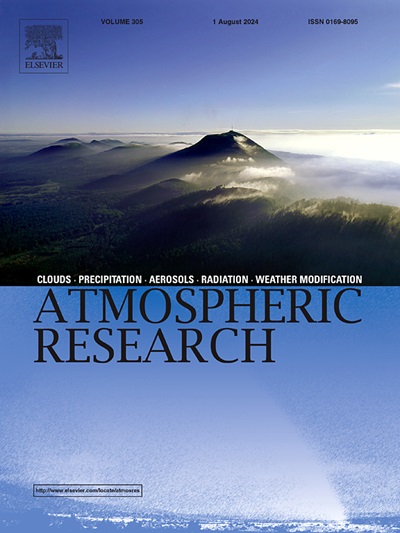7 - 8月北印度洋-南海年代际变化对东亚夏季风演变的影响
IF 4.4
2区 地球科学
Q1 METEOROLOGY & ATMOSPHERIC SCIENCES
引用次数: 0
摘要
东亚夏季风(EASM)影响中国夏季气候。从7月到8月是梅雨季和华北/东北雨季之间的关键转折,但这一时期降水月际变化的潜在驱动因素尚不清楚。研究了7 - 8月北印度洋(NIO)-南海(NIO- scs)海温异常(SSTAs)与中国东部降水月际演变的关系。1995/96年前后NIO-SCS ssta与中国东部降水关系的显著年代际变化1995年以前,整个7月和8月,温暖的NIO-SCS SSTAs持续增强了淮河-长江流域(HYRB)的降水,主要是由太平洋-日本(PJ)遥相关型改变的。然而,1996年以后,一个明显的模式出现了:温暖的NIO-SCS ssta在7月增加了HYRB上空的降水,同时减少了华北/东北地区的降水。相比之下,这种模式在8月份发生了逆转。根据观测和数值试验,年代际变化与1996年以后印度洋海温较以前减弱有关。1996年后,7月较冷的印度洋海温减弱了开尔文波,使PJ型向西移动,并广泛影响了中国东部的降水。8月,较冷的印度洋海温诱发了向西移动的Walker环流异常,菲律宾海附近的下降分支延伸至30°N,导致HYRB降水减少,中国北部/东北地区降水增加。此外,1996年后NIO-SCS ssta振幅的减小可能归因于ENSO春季振幅的减弱,这可能与大西洋多年代际涛动的正相有关。本文章由计算机程序翻译,如有差异,请以英文原文为准。
Interdecadal shift in North Indian Ocean-South China Sea influence on the evolution of the East Asian summer monsoon from July to August
The East Asian Summer Monsoon (EASM) shape China's summer climate. The transition from July to August marks a critical shift between the Meiyu season and the North/Northeast China rainy season, yet the underlying drivers of the inter-monthly evolution in precipitation during this period remains unclear. This study investigates the relationship between sea surface temperature anomalies (SSTAs) in the northern Indian Ocean (NIO)-South China Sea (NIO-SCS) and the inter-monthly precipitation evolution in eastern China during July–August. A significant interdecadal shift in the relationship between the NIO-SCS SSTAs and eastern China's precipitation around 1995/96. Before 1995, warm NIO-SCS SSTAs consistently enhanced precipitation in the Huaihe-Yangtze River Basin (HYRB) throughout July and August, primarily altered by the Pacific-Japan (PJ) teleconnection pattern. However, after 1996, a distinct pattern emerged: warm NIO-SCS SSTAs increased precipitation over the HYRB and simultaneously reduced precipitation in North/Northeast China in July. In contrast, this pattern is reversed in August. Based on observations and numerical experiments, the interdecadal shift is linked to a weakening of Indian Ocean SSTAs after 1996 compared to before. During the post-1996, cooler Indian Ocean SSTAs in July weaken the Kelvin wave, shifting the PJ pattern westward and broadly influencing precipitation across eastern China. In August, the cooler Indian Ocean SSTAs induce westward-shifted Walker circulation anomalies, with a descending branch near the Philippine Sea extending to 30°N, leading to decreased precipitation in the HYRB and increased precipitation over North/Northeast China. Furthermore, the reduction in NIO-SCS SSTAs' amplitude after 1996 may be attributed to a weakened spring ENSO amplitude, potentially linked to the positive phase of the Atlantic Multidecadal Oscillation.
求助全文
通过发布文献求助,成功后即可免费获取论文全文。
去求助
来源期刊

Atmospheric Research
地学-气象与大气科学
CiteScore
9.40
自引率
10.90%
发文量
460
审稿时长
47 days
期刊介绍:
The journal publishes scientific papers (research papers, review articles, letters and notes) dealing with the part of the atmosphere where meteorological events occur. Attention is given to all processes extending from the earth surface to the tropopause, but special emphasis continues to be devoted to the physics of clouds, mesoscale meteorology and air pollution, i.e. atmospheric aerosols; microphysical processes; cloud dynamics and thermodynamics; numerical simulation, climatology, climate change and weather modification.
 求助内容:
求助内容: 应助结果提醒方式:
应助结果提醒方式:


